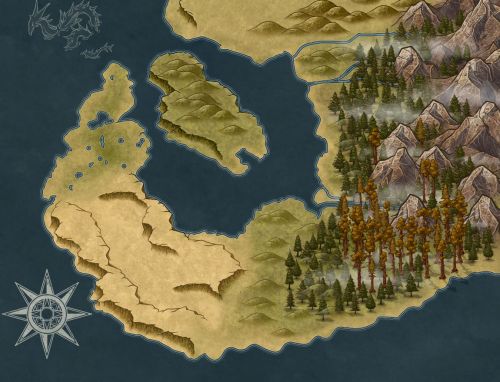Azcuche
Xarlac Peninsula
With mild weather moderated by a long, sunny coastline, the Xarlaca Peninsula is about 200 square miles of idyllic countryside. Xarlaca, the city of wonders, gives the peninsula its name, but the slower, provincial lifestyle of the smaller farming villages such as Aldeata are more typical of the region.
Climate. The island has a predictable Mediterranean climate, with hotter, dry summer days that can end in wild fires and mild, wet winters that can end in mudslides and then magnificent blooms. However, every seven years, the normal pattern is disrupted. The peninsula has either significantly heavier than normal rains during the season of rains and well into the season of blooms, rotting the new vegetation and burying it under mud. Or, more rarely, it experiences a drought year with significant wildfires and a poor bloom season.
Flora. Hardy, xeric shrubs thrive in the mild temperatures and gentle winter rains of the peninsula's chaparral environment. Flowering buckwheat, silvery artemisia, spindly sage, delicious lemonade berry bush, tall greasewood bushes with their tiny leaves, wild cucumber vines with their intricate seed pods, and succulents shaped like mounds of juicy green pebbles all provide delights to the senses. However, some of the plants are well -defended, like the agaves and yuccas with leaves like clumps of swords, the long-spined barrel cactus, and spreading prickly pear.
Scattered throughout are the chaparral trees: tall, white-barked sycamores, ancient, spreading coastal oaks, shrubby black walnut trees and scrub oaks, picturesque, flowering manzanitas with their smooth red bark, mountain mahoganies with their curled leaves and dense wood, and twisted pines on the high slopes.
Fauna. Large mammals include herds of wooly bison and black bears, smilodons and dire wolves. Smaller ones include th e adaptable coyotes, sharp-antlered mule deer, vicious wild boar, solitary grey foxes, skinny-tailed ground squirrels, tiny mice, agile kangaroo rats, ornate shrews with their pointy noses, and carnivorous spotted skunks.
Birds include the majestic bald eagles, mottled cactus wrens with their low, raspy chirp, grey quails who love to run, red capped woodpeckers, plump black gnatcatchers, bright blue-headed scrub jays, mysterious barn owls, spotted kestrels, yellow-and-black faced horned larks, yellow-bellied meadowlark, and gregarious brown pelicans.
Lizards do particularly well in the warm sunny climate of the island, with horned lizards, fence lizards, night lizards, and banded geckos being most common. There are few snakes, mostly tan rattlesnakes and patch-nosed snakes, with a rare sighting of a rosy boa.
Butterflies, lacewings, and moths cover the land in their seasons, highlighted by the copper butterfly festival in spring. The stinging insects are fewer and usually have agreements with the humans of the islands, with specialists in charge of treating with the wasps, honey bees, yellow jackets, and biting flies.
The seas around the peninsula teem with life. Furry, sleek seals and sea lions sun themselves on rocky outcroppings in their communes. Dolphins and orcas power through the waves: friendly, playful, and violent in turn. Flickering schools of mackerel, sardines, and smelt confuse predators with their numbers while yellowtails and white sea bass use their size and speed to stay safe. Bat rays, moray eels, swell sharks, tiger sharks, and great white sharks glide silently through the sea bottoms. In deep waters, spotted gray whales sing old songs of space and time as they migrate past the island.
Geology. The Xarlac peninsula is rocky, with hard, black-and-white-speckled granite throughout the island which the Xarlacans use in everything from pavement to monuments. The south of the island holds pockets of crumbly, colorful schist rock stained rust red or olive green. The greenschist holds valuable streaks of waxy green serpentine, which the islanders polish and carve to use in decorations and jewelry. The coarsely grained red schist hides garnets, most small as sand grains, but a few large enough to use for jewelry and much prized by rich merchants and the powerful among the great clans. Bluehall alchemical gardeners have started experimenting with the schist, trying to grow and work the minerals the way orchardists grow their trees.
Anabe Dry Lands
Secobusque Mountains
Sierra LomaMaps
-
Azcuche Region
Azcuche is a region inspired by the South West, from the mild Channel Islands of the California coast to the vast Chihuahuan Desert of Texas and Mexico and everything inbetween.




Comments